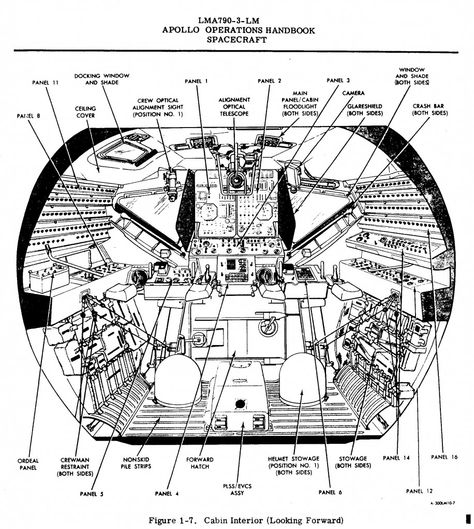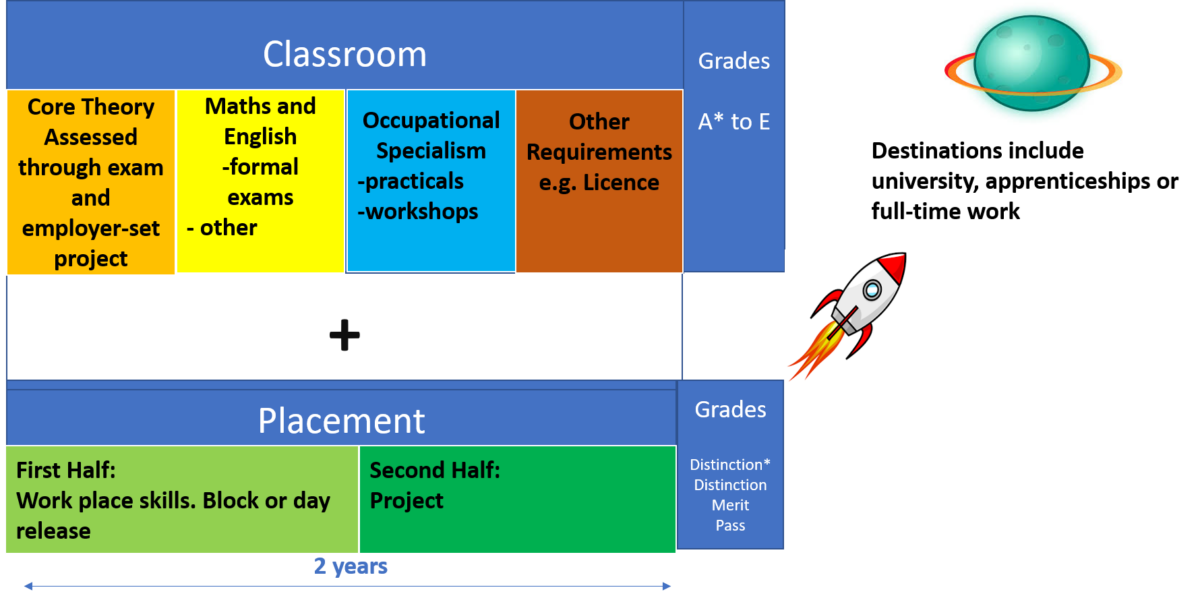T Levelling Up: The “Levelling Up” Agenda Must Result in Equality with A Levels

T Levels are Ready for Take-Off
The impressive new T levels are sitting on the launch-pad ready for take-off, one of the few things that can actually take off in these unprecedented times of uncertainty. A quick survey of assorted friends reveals that not many people have heard of them but with the promise of big PR campaigns to come, including TV advertisements, that should change.

The new qualifications were the brainchild of the Sainsbury Review and the re-elected Tories made a commitment to provide a clearer and higher quality journey for technical education at level 3, aiming to share the same orbit as A levels and Apprenticeships; the challenge being to convert 13,000 post-16 disparate current vocational qualifications into a less-confusing mere 15 ‘routes’ and 25 ‘pathways’ to skilled employment. T levels are the paving stones.
T Levels have been designed with the input of employers big and small to address the skills gap, to drive up productivity, raise aspirations and, as a result, support social mobility; this all fits in perfectly with the current political agenda of ‘levelling up’ and ‘self-sufficiency’, to utilise local talent for local business in a post-Brexit (remember that?), post-Covid Britain.
It’s not just words, that Government commitment is bolstered by £500 million each year to help pay for the extra teaching hours and organising the associated work placements.
Way back in 2016 when the Post-16 Skills Plan was launched by the Government, the then Minister for Skills, but now seatless Nick Boles hit the nail on the head:

“Technical education remains the poor relation of academic education. The choice of courses and qualifications can be confusing, and links to the world of work are not strong enough. Perhaps most significantly, we have not paid enough attention to the lessons of the past or from abroad.”
He made some crucial points, which must be resolved for T levels to stand any chance of succeeding; the brand must be strong, positive and long-lasting through student engagement and good teaching; the product must be streamlined, and; the work experience must stretch beyond just making the brews for your boss.
Overall, the vocational education odyssey must produce more highly-skilled, employable young people.

Technical skills must enjoy gravity-defying parity of esteem with academic qualifications, as it works in Germany. In fact, according to Gavin Williamson, the former Education Secretary, technical education opportunities in the UK are on a trajectory to surpass Germany by 2029. Aim high, Gav.
Houston, we have a problem
In light of current events back on Earth, the rollout has been ominously sporadic. Secretary of State for Education, Gillian Keegan, has delayed the introduction of some of the new T-levels in hairdressing, barbering and beauty therapy; craft and design; catering; and media, broadcast and production, saying:
“T-level technical qualifications will only be approved where we are sure they are good enough and can be delivered to a high standard.”
Watch this space. Whether it’s mission aborted this year or not, lift off will still happen.
This is the first in a three part blog where I’ll look at an overview of T levels and things to consider, then on to the theory behind reflective practice, one of the key life and employability skills which students need to develop as part of the T level programme and then on to the final destination: how we expect this to work in practice.
First of all…..what’s under the bonnet
T Levels are the exciting new post-GCSE Level 3 study programmes for 16 to 19-year-olds; the alternative to A levels for the more career-focussed individual. The purpose of T levels is to boost skills of young people, in a economy-wide range of sectors representing next gen British workplace, such as media, catering, healthcare science and hair and beauty. They are being introduced in waves over a five-year period.

The first three ‘pathways’, Childcare, Digital and Construction were introduced to a ‘designated’ school or college course ‘provider’ near you, starting in September 2020; 64 of them by 2021 to be precise, all of which must have an Ofsted rating of good or outstanding to ensure quality and instil confidence.
The Qualification = Classroom + Placement
The T Level courses train students in practical skills and knowledge in their chosen industry. The key innovation, which hasn’t been successfully achieved before, is that they will combine the theory learned in the classroom with practical learning which is supported by a mammoth industry placement of at least 315 hours for each student. Students will also train for an ‘occupational specialism’ which is testing skills and knowledge for the specific occupation.
The T level qualification, it’s suggested, will have the same status as completing 3 A levels; the top score being the equivalent of 3 A*s.
This combination is illustrated in the diagram. The overall aim is to offer a rocket platform to higher level study, apprenticeships or highly skilled work and ultimately better employment opportunities.

In the Classroom
Pay attention, everyone! Classroom time varies for the different qualifications. See the table below. The traditional A levels are 100% work in the classroom. In an Apprenticeship most of the qualification time is spent ‘on the job’, ‘learning the ropes’ as it were. T levels sit in the gap in the middle.

Core and Satellite
The classroom element will include broad knowledge-based ‘core content’ of the technical theory, concepts and skills, supported with the ‘must-have’ satellites of practical English, Maths, Digital skills and occupational teachings specific to each vocation.

For example, in the Education and Childcare T level there are three occupational specialisms within the qualification, these are; Early Years Education and Childcare, Assisting Teaching, and Supporting and Mentoring Students in Further and Higher Education.
There is also a project set by employers to replicate experience of a workplace environment; this is set in the second half of the work placement. Students are set real-life scenarios, for example, on the design, surveying and planning for construction course, an engineering project could include having to prepare a report for the design of a new development with supporting calculations, analysis and drawings.
Grading
The grading system is a hybrid of the current grading for A levels and BTechs; with one eye on equality, the classroom work earns the grading of A levels, but the placement and occupational specialism operate on the Pass/Merit/Distinction system of the predecessor exams.
The actual overall qualification results will follow the format of Pass, Merit, Distinction and Distinction*. This may lead to some confusion.
T Level Work Placements Masterstroke
The master stroke for the T levels is the work placements. This provides a fantastic opportunity to apply the theory and the technical skills learned in the classroom in a real work setting, working for an employer over an extended period (of a minimum of 315 hours =45 days= 1 ½ months) in a role directly relevant to their course.
This is great preparation for the world of work and helps students to develop potential connections to secure a job once they are ready to apply. The qualifications will meet the needs of industry, because the content has been designed in collaboration, according to the DfE, with more than 200 businesses big and small.
Although, some stones might be unturned here as there are around 5 million businesses in total in the UK. Rather worryingly, the Federation of Small Businesses said that only 6% of their members would be willing to offer placements and the DfE is currently carrying out further research as they are concerned there could be insufficient support from businesses especially in rural areas and especially after the Coronavirus crisis.
This is mission critical.
Game of two halves
The purpose of the placement is to enable the learner to understand more about how the theory works in practice, what skills are required and a chance to practise them. In the second half of the placement the student has to plan and effect a project focussed on a specific skill or area. It means that they should be thinking about what subject the project should relate to and start planning in the first half. The project gives the work placement focus, context and evidence of achievements.

Employer’s happy, Student’s happy, Everybody’s happy
The student gets valuable work experience in a sector of their choice. But what does the employer get? There are numerous benefits accruing to the companies offering work placement.
Firstly, it is a low cost method of capitalising on a previously untapped talent pool for entry level jobs and it is an opportunity for companies to build their talent pipeline with young people so that they have the potential to offer careers to the ‘work-fit’ learners they believe will fit into their culture, whilst considering other factors such as diversity.
If a firm doesn’t have enough hours to fulfil the commitment of a minimum 315 hours of work experience to one student, then this can be divided with other partner employers.
The Missing Link; The Student’s Logbook Bonds Theory and Practice
Each student is expected to maintain a T Level placement logbook. It provides the link which cements the theory learned in class with the practice the students see out in the field. It might seem innocuous, but this is a very important aspect of the skill and personal development of the students.
There is basic, boring content, such as hours completed and verified attendance record each week, but then there’s exciting stuff when students have fortnightly ‘reflection’ pages to complete which help them make sense of it all supported by reviews by their workplace mentor and tutor.
This is a crucial part of learning and development and the logbook can be a channel for discussion and guidance. The power of reflection is something I’m going to talk about more in the second blog.
But what about those who aren’t quite ready for the step up? Won’t that ruin the pass rates? Well, they’ve thought of that and the solution is the….
The Transition Programme
This is a great addition to the T level suite. Not every potential applicant leaving school at 16 will be ready to embark on an untested and daunting T level programme. For those who are deemed to have the potential to progress, they can join a Transition Programme; a tailored (by the college), what you might call foundation programme for “further preparation”.
Transition Programmes will be phased in alongside the introduction of T Levels in September 2020 and will deliver ‘oven-ready’ T level students at 17 for graduation by age 19.
This will ensure their students have the best opportunity to build up the academic and technical skills, knowledge and behaviours (oh, and confidence!) required to progress to a full T Level, and to successfully complete it.
All safety checks have been done. Ground Launch Sequences are activated, the countdown is ticking, T minus….ten, nine, eight……meanwhile in the second in our series of three articles we are going to turn our attention to one specific aspect of the T level education, the log book, and the key ingredient which is required to make it work….the art of reflection.
Neil Wolstenholme, Chairman, Kloodle












Responses